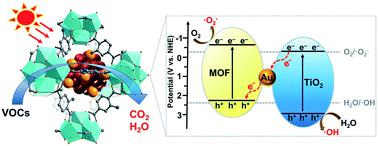当前位置:
X-MOL 学术
›
Environ. Sci.: Nano
›
论文详情
Our official English website, www.x-mol.net, welcomes your feedback! (Note: you will need to create a separate account there.)
Boosting the photocatalytic degradation of ethyl acetate by a Z-scheme Au–TiO2@NH2-UiO-66 heterojunction with ultrafine Au as an electron mediator
Environmental Science: Nano ( IF 7.3 ) Pub Date : 2021-07-06 , DOI: 10.1039/d1en00225b Hongli Liu 1, 2 , Xiaoyi Chang 1, 2 , Xiaoxun Liu 1, 2 , Guiying Li 1, 2 , Weiping Zhang 1, 2 , Taicheng An 1, 2
Environmental Science: Nano ( IF 7.3 ) Pub Date : 2021-07-06 , DOI: 10.1039/d1en00225b Hongli Liu 1, 2 , Xiaoyi Chang 1, 2 , Xiaoxun Liu 1, 2 , Guiying Li 1, 2 , Weiping Zhang 1, 2 , Taicheng An 1, 2
Affiliation

|
TiO2 based photocatalytic oxidation has been regarded as a promising technology for VOC removal, although it remains challenging in view of the limited visible light response and low photogenerated charge separation efficiency. Herein, a charge space separated Z-scheme Au–TiO2@NH2-UiO-66 photocatalyst was synthesized for highly efficient degradation of VOCs by encapsulation of Au and TiO2 into visible light responsive NH2-UiO-66 with Au nanoclusters as electron mediators. The obtained Au–TiO2@NH2-UiO-66 nanocomposite could broaden the light absorption of TiO2 from the UV to visible region due to the excellent localized surface plasmon resonance of Au nanoclusters confirmed by UV-vis diffuse reflectance. Furthermore, electron paramagnetic resonance, photoelectrochemical measurements, steady-state PL spectra and time-resolved PL spectra unveil that the Au–TiO2@NH2-UiO-66 ternary photocatalyst followed the Z-scheme mechanism and the ultrafine Au on this heterojunction as an electron mediator can significantly accelerate photogenerated electron transfer. Due to the enhanced interfacial electron transfer by the Au electron mediator and high redox abilities of photogenerated carriers in the Z-scheme heterojunction, the Au–TiO2@NH2-UiO-66 nanocomposite greatly boosted the separation efficiency of photogenerated electron–hole pairs, thus producing abundant strong oxidative species, including photogenerated holes, ˙O2− and ˙OH radicals, to mineralize VOCs. Impressively, the mineralization efficiency reached 85% at 94.6% ethyl acetate degradation over the 1 wt% Au–TiO2@NH2-UiO-66 photocatalyst within 360 min of xenon lamp irradiation, which was 12.1, 10.6 and 2.83 times higher than that of TiO2, NH2-UiO-66 and TiO2@NH2-UiO-66, respectively. This work would provide a valuable guideline in the synthesis of highly efficient visible light responsive photocatalysts for VOC degradation.
中文翻译:

以超细金为电子介体的 Z 型 Au-TiO2@NH2-UiO-66 异质结促进乙酸乙酯光催化降解
基于TiO 2的光催化氧化被认为是一种很有前途的VOC去除技术,尽管鉴于有限的可见光响应和低光生电荷分离效率仍然具有挑战性。在此,通过将 Au 和 TiO 2封装成具有 Au 纳米团簇的可见光响应 NH 2 -UiO-66,合成了一种电荷空间分离的 Z 型 Au-TiO 2 @NH 2 -UiO-66 光催化剂,用于高效降解 VOC。电子介体。获得的Au-TiO 2 @NH 2 -UiO-66纳米复合材料可以拓宽TiO 2的光吸收由于通过 UV-vis 漫反射证实了 Au 纳米团簇的优异局部表面等离子体共振,从 UV 到可见光区域。此外,电子顺磁共振、光电化学测量、稳态 PL 光谱和时间分辨 PL 光谱揭示了 Au-TiO 2 @NH 2 -UiO-66 三元光催化剂遵循 Z 型机制,并且该异质结上的超细 Au 为电子介体可以显着加速光生电子转移。由于Au电子介体增强的界面电子转移和Z型异质结中光生载流子的高氧化还原能力,Au-TiO 2 @NH 2-UiO-66纳米复合材料极大地提高了光生电子-空穴对的分离效率,从而产生了丰富的强氧化物质,包括光生空穴、˙O 2−和˙OH自由基,以矿化VOCs。令人印象深刻的是,在氙灯照射 360 分钟内,1 wt% Au-TiO 2 @NH 2 -UiO-66 光催化剂在 94.6% 乙酸乙酯降解时矿化效率达到 85%,分别是12.1、10.6和 2.83 倍分别为 TiO 2、NH 2 -UiO-66 和 TiO 2 @NH 2 -UiO-66。这项工作将为合成用于 VOC 降解的高效可见光响应光催化剂提供有价值的指导。
更新日期:2021-07-27
中文翻译:

以超细金为电子介体的 Z 型 Au-TiO2@NH2-UiO-66 异质结促进乙酸乙酯光催化降解
基于TiO 2的光催化氧化被认为是一种很有前途的VOC去除技术,尽管鉴于有限的可见光响应和低光生电荷分离效率仍然具有挑战性。在此,通过将 Au 和 TiO 2封装成具有 Au 纳米团簇的可见光响应 NH 2 -UiO-66,合成了一种电荷空间分离的 Z 型 Au-TiO 2 @NH 2 -UiO-66 光催化剂,用于高效降解 VOC。电子介体。获得的Au-TiO 2 @NH 2 -UiO-66纳米复合材料可以拓宽TiO 2的光吸收由于通过 UV-vis 漫反射证实了 Au 纳米团簇的优异局部表面等离子体共振,从 UV 到可见光区域。此外,电子顺磁共振、光电化学测量、稳态 PL 光谱和时间分辨 PL 光谱揭示了 Au-TiO 2 @NH 2 -UiO-66 三元光催化剂遵循 Z 型机制,并且该异质结上的超细 Au 为电子介体可以显着加速光生电子转移。由于Au电子介体增强的界面电子转移和Z型异质结中光生载流子的高氧化还原能力,Au-TiO 2 @NH 2-UiO-66纳米复合材料极大地提高了光生电子-空穴对的分离效率,从而产生了丰富的强氧化物质,包括光生空穴、˙O 2−和˙OH自由基,以矿化VOCs。令人印象深刻的是,在氙灯照射 360 分钟内,1 wt% Au-TiO 2 @NH 2 -UiO-66 光催化剂在 94.6% 乙酸乙酯降解时矿化效率达到 85%,分别是12.1、10.6和 2.83 倍分别为 TiO 2、NH 2 -UiO-66 和 TiO 2 @NH 2 -UiO-66。这项工作将为合成用于 VOC 降解的高效可见光响应光催化剂提供有价值的指导。


























 京公网安备 11010802027423号
京公网安备 11010802027423号